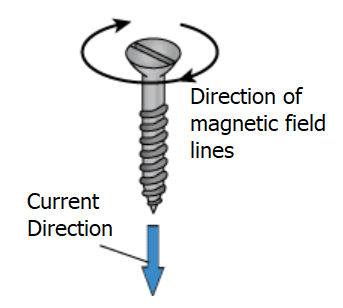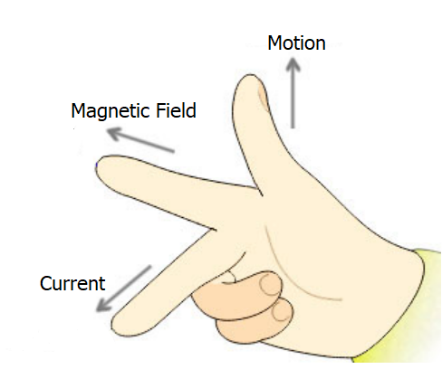
Answer
466.2k+ views
Hint
The direction magnetic field due to a current-carrying conductor can be determined using various rules such as Fleming’s right-hand rule and Maxwell’s corkscrew rule.
Complete step by step answer
According to Maxwell’s corkscrew rule or right-hand screw rule, the direction of magnetic lines of force can be determined in association with the direction of the current. Consider a right-handed screw being placed along the direction of current-carrying linear wire such that it is rotated downward in the direction of the current. When the screw is rotated downward, then the direction of the right-handed rotation of the screw will depict the direction of the magnetic field lines as shown in the figure.

Therefore, (D) Maxwell’s corkscrew rule is the correct answer.
Additional information
The direction of the magnetic field can also be determined using Fleming’s right-hand rule. According to this rule, the fingers of the right hand are stretched such that the thumb, forefinger, and the middle finger are placed perpendicular to each other. If the thumb points in the direction of the motion of the current-carrying conductor and the middle finger depict the direction of the current, then the forefinger will give the direction of the magnetic field as shown in the figure.

Note
Electric fields can be determined when the charge is in rest. However, the magnetic field can be determined when the charge is in motion. It cannot be determined in the rest position of the charge.
The direction magnetic field due to a current-carrying conductor can be determined using various rules such as Fleming’s right-hand rule and Maxwell’s corkscrew rule.
Complete step by step answer
According to Maxwell’s corkscrew rule or right-hand screw rule, the direction of magnetic lines of force can be determined in association with the direction of the current. Consider a right-handed screw being placed along the direction of current-carrying linear wire such that it is rotated downward in the direction of the current. When the screw is rotated downward, then the direction of the right-handed rotation of the screw will depict the direction of the magnetic field lines as shown in the figure.

Therefore, (D) Maxwell’s corkscrew rule is the correct answer.
Additional information
The direction of the magnetic field can also be determined using Fleming’s right-hand rule. According to this rule, the fingers of the right hand are stretched such that the thumb, forefinger, and the middle finger are placed perpendicular to each other. If the thumb points in the direction of the motion of the current-carrying conductor and the middle finger depict the direction of the current, then the forefinger will give the direction of the magnetic field as shown in the figure.

Note
Electric fields can be determined when the charge is in rest. However, the magnetic field can be determined when the charge is in motion. It cannot be determined in the rest position of the charge.
Recently Updated Pages
Fill in the blanks with suitable prepositions Break class 10 english CBSE

Fill in the blanks with suitable articles Tribune is class 10 english CBSE

Rearrange the following words and phrases to form a class 10 english CBSE

Select the opposite of the given word Permit aGive class 10 english CBSE

Fill in the blank with the most appropriate option class 10 english CBSE

Some places have oneline notices Which option is a class 10 english CBSE

Trending doubts
Fill the blanks with the suitable prepositions 1 The class 9 english CBSE

How do you graph the function fx 4x class 9 maths CBSE

Which are the Top 10 Largest Countries of the World?

What is the definite integral of zero a constant b class 12 maths CBSE

Who was the Governor general of India at the time of class 11 social science CBSE

Distinguish between the following Ferrous and nonferrous class 9 social science CBSE

Name five important trees found in the tropical evergreen class 10 social studies CBSE

The Equation xxx + 2 is Satisfied when x is Equal to Class 10 Maths

Differentiate between homogeneous and heterogeneous class 12 chemistry CBSE




